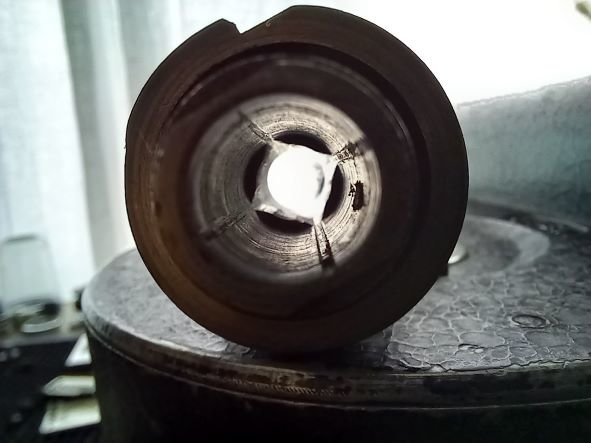-
Posts
2,589 -
Joined
-
Last visited
Everything posted by Simon Wyss
-
A 35-mm theatrical release print of 100 minutes is about 21 kg of material. The equivalent in 16 mm weighs the tenth of it and consists of two rolls. For the average screen height of three meters (10 ft.) 16 mm is perfect. Reduction prints and outprints from data look fine. 16 mm has always been a distribution format of the industry, it was George Eastman's choice of a 1919-20 Bell & Howell proposal (⅝"). He was in contact with Charles Pathé who went for Ferdinand Zecca's proposal of the third part of the Kok system (1⅛"). Both envisaged to conquer a giant dormant market: everybody at home. So 16-mm film is one of a few alternatives if we need to break out from the costly burden of 35.
-

Push/Pull process, temp vs timing???
Simon Wyss replied to James Steven Beverly's topic in Film Stocks & Processing
Well, generally there's the tendency towards the magenta layer to exaggerate with either pushing (prolonged developing time) or raising the temperature. This has been the top concern of Eastman-Kodak chemists with the older (and discontinued) color print films, I think it was 5384/7384. But that is an inherent issue as old as multi-layer colour film exists. Modern color film chemistry had to become balanced over so many factors. There is the p-H value, you know, proton concentration or acidity/alkalinity — very important, also agitation, and almost unknown: surface activity or better ion activity at the interface gelatine-liquid. It can make some difference whether the film enters the developing bath directly or whether it comes from an alkaline prebath such as it is still employed for the removal of backings. They are right now trying to do without a rem-jet soot gelatine backing layer. Still I'm certain that you will master this all. Note everything like a donkey and learn from experience in your actual situation: water, machine, and so on. Thank you for your faith. -

Check out my new trailer (cartoon, cinema-style)
Simon Wyss replied to Jacob Stalhammar's topic in General Discussion
Roligt -

Push/Pull process, temp vs timing???
Simon Wyss replied to James Steven Beverly's topic in Film Stocks & Processing
Steven, this is one of the most complicated subjects. Why ? Because one — you have three separate color layers if not the double number with certain stock which are chemically affected one after the other through time (logically), two— the layers will never react precisely in parallel manner, so we have to deal with color shifts, three — speed, actually density developed out after a certain formula, depends primarily on the chemistry (the most complex variable of all), four — exposure, in itself the product of light intensity and time, so a certain light amount, makes non-linear differences (Schwarzschild effect), and five — temperature variations again do not always give linear changes. Point four can be deleted in printing since exposure time remains mostly constant. Point one is connected with point five. Point two may be corrected for by densitometric evaluation and subsequent programing. I think that the manufacturers tend to recommend everything standard, you know, along their guidelines and chemicals. Cinema projection calls for a standard print density. Lab managers speak Laboratory Aim Density, a Kodak invention. Directors and DP almost invariably want to move between the extremes, often without any knowledge of film projection physics. Worse even the electronically risen people. Start studying this field of interest with a crisp black-and-white print in a theater. Check out what happens with you in high-key scenes and in low-key scenes. Then compare color imagery to it. -
Guillaume, what are your points now ?
-
Daniele, there is ORWO UN 54 and ORWO N 74. There's no un74. Panchromatic Universal Negative 54 film is rated ISO 100. Panchromatic Negative 74 film is rated ISO 400. They are modern stocks with nice tones. I think in black and white you shouldn't worry about the stock but about the lighting.
-
Canada is very special.
-
Friend, how can COMMAG or COMOPT sound become off-synch ?
-
Furniture polish ain't worst thing after a thorough cleaning, believe me. Oh, that reminds me of Steve Martin in Dead Men Don't Wear Plaid: C-l-e-a-n-i-n-g---W-o-m-a-n . . .
-
Charles, will you now go down there and fetch that bottle ! This is the sort of mistakes which ruins civilization. Do you want me to not sleep anymore ?
-
Funny, in Europe it's Rodinal. When it was put on the market by Agfa Mr. Auguste Rodin was en vogue.
-
When things are getting wet you're better off with a metal leg tripod. Wipe and dry it, pack it up. For the rest: wood. Naturally. It's warm, it ages with you. I like wood around: sticks, slate, fold chair, a table to sit at, the board before my head.
-
Correct, again. It is the sodium sulfite which acts first as conserving agent for the reducing agents, second as a weak alkali and third as a solvent of silver halides.
-
Hey, filmers and producers Should like to make your acquaintance as a movie lab technician and manager. I have seen that they open at Libertine at 6 pm now. Who'd be around between February 2 and 26 ?
-
Correct. Only this added: D-76 and D-96 are not true fine grain developers. For such intention one has to switch to a different family of reducing agents. Lumière and Seyewetz came up with paraphenylenediamine and orthoaminophenol in 1904.
-
Let's see now, Eastman-Kodak D(eveloper Recipe) 76 of 1927 is made out of 750 ml water at 50º C to begin, 2 g Metol, 100 g dehydrated sodium sulfite, 5 g Hydroquinone, and 2 g Borax, to be completed for 1000 ml. Replenisher (solution) contains 3 g Metol, 100 g sodium sulfite, 7.5 g Hydroquinone, 20 g Borax. D. 96 or D-96 provides for Metol and Hydroquinone in a 1:1 ratio, namely 1.5 g of each per 1000 ml, 75 g of sodium sulfite, 0.8 sodium bromide, and 4.5 g of Borax (sodium-tetraborate-10-hydrate). The emulsion of a stock like Eastman Plus-X negative -231 is in no point different from the still photography Plus-X film. Tri-X ciné film wouldn't be anything else than photo Tri-X coatings, either. Only the more recent T(afelkristall)-Max emulsions behave in a little other manner. Can anybody explain us in detail what happens when a cubic silver-salt gelatine film is bathed in developer solutions like these? Where would differences come from? With all classic films you have silver "wool" protuberances that actually form the visible image's delineation. That is basically inherent with the chemical developing contrary to physical developing which is a more fine-grained silver deposit out of the solution on the light-struck crystals. If you want better black-and-white imagery (at the price of less sensitivity gain) you may try Gigabitfilm®. I'll be in Los Angeles during February.
-
The combination of 7222 and D-76 is something most harmless. You cannot fail. I have nine years experience in commercial hand-processing of movie film.
-
Karl, you got me by a hair I don't smoke, I swear
-
You know what old school is? It's editing the negative directly in front of the window with a pair of scissors. My o my.
-
If I may say something as an editor although also done assistance and camera: There are different makes and sizes of slates. I personnally prefer black ones with chalk writing because it appears dark again in the dailies which relieves some eye strain. Most importantly don't pound the stick but give it a gentle clap after a clear announcement, and yes, bring it in open and hold it closed for a moment. That way it is a joy to do the synch work. Also it can be very helpful if the clapper is in some cooperation with the sound recordist with regard to such details like sound roll number and microphone channel. To be noted on the slate
-
Bob, if you had the kindness to state something of a budget figure everybody else here will be able to tell you much more than what is possible and pleasing now. You can give a fantasy number like 26K (USD 26,000). Nobody will object. I personally suggest that you start your project in a cinema studying black-and-white pictures. Sit closer to the screen and imagine that it's the viewfinder image what you're seeing.
-

Kodak B&W Neg IR sensitivity
Simon Wyss replied to Gregory Almond's topic in Film Stocks & Processing
Yes, it is. The rest has to do with the lenses. -

lux level calculations for key and fill
Simon Wyss replied to Ollie Bartlett's topic in Lighting for Film & Video
O, thank you for the definition. -
Karl, it wasn't my intention to be grabby and then my synching abilities are much more on the technical side. I ain't any comedian. Matthew, Hitler was a marionette. The real monsters team behind curtains. It takes rich people to start a war, not an psychotic unemployed artist painter. George Bush jun. is about the same heartily goofer monitored from beginning, and there are many more. Does anybody know why that apparatus was named RED at all ?


